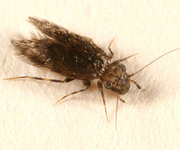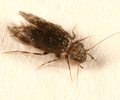Atropetae
Emilie Bess and Kevin P. Johnson


This tree diagram shows the relationships between several groups of organisms.
The root of the current tree connects the organisms featured in this tree to their containing group and the rest of the Tree of Life. The basal branching point in the tree represents the ancestor of the other groups in the tree. This ancestor diversified over time into several descendent subgroups, which are represented as internal nodes and terminal taxa to the right.

You can click on the root to travel down the Tree of Life all the way to the root of all Life, and you can click on the names of descendent subgroups to travel up the Tree of Life all the way to individual species.
For more information on ToL tree formatting, please see Interpreting the Tree or Classification. To learn more about phylogenetic trees, please visit our Phylogenetic Biology pages.
close boxIntroduction
Infraorder Atropetae includes families Lepidopsocidae, Psoquillidae, and Trogiidae and comprises 31 genera and about 300 species distributed worldwide. The North American fauna includes 25 species from 13 genera.
Characteristics
Synapomorphies
- In the female:
- The ovipositor is composed of the elongated external valves of the gonapophyses joined together at midline by a membrane.
- The presence of glandular accessory bodies in the spermathecal sac.
General Characters
- Head:
- Head is short and broad.
- Antennae have more than 18 segments without ringed sculpturing (annulations).
- Legs:
- Tarsi have 3 segments
- Wings:
- Adults can have full-length or short wings or can be wingless.
- Wings are covered with hairs or scales.
- Forewing veins CuP and A1 reach the wing margin separately, so nodulus is absent.
- Hindwing vein A does not branch.
- Female:
- Paraproct has an anal spine.
- Ovipositor is composed of the fused, elongate external valves of the gonapophyses.
- Spermathecal sac has one or two glandular accessory bodies.
- Male:
- Paraproct has an anal spine.
- Phallosome is composed of two arms that are never fused anteriorly.
Discussion of Phylogenetic Relationships
Monophyly of infraorder Atropetae is supported by two characters of the female genitalia: the ovipostior composed of the elongated external valves of the gonapophyses joined together at midline by a membrane, and the presence of glandular accessory bodies in the spermathecal sac. Molecular analysis of nine species of Atropeae also supports the monophyly of the infraorder and indicates a sister relationship between families Trogiidae and Psoquillidae (genes 18S & Histone3 nDNA, 16S rDNA; Yoshizawa et al. 2006).
References
Lienhard, C. and C.N. Smithers. 2002. Psocoptera (Insecta) World Catalogue and Bibliography. Muséum d'Histoire Naturelle, Geneva, Switzerland.
Mockford, E.L. 1993. North American Psocoptera (Insecta). Gainesville, Florida: Sandhill Crane Press.
Smithers, C.N. 1996. Psocoptera. Pp. 1-80, 363-372 (Index) in Wells A. (ed.) Zoological Catalogue of Australia. Vol. 26. Psocoptera, Phthiraptera, Thysanoptera. Melbourne: CSIRO Publishing, Australia.
Smithers, C.N. 1972. The classification and phylogeny of the Psocoptera. Memoirs of the Australian Museum 14: 1–349.
Yoshizawa, K., C. Lienhard, and K.P. Johnson. 2006. Molecular systematics of the suborder Trogiomorpha (Insecta: Psocodea: ‘Psocoptera’). Zoological Journal of the Linnean Society 146: 287–299.
Title Illustrations

| Scientific Name | Echmepteryx hageni |
|---|---|
| Location | Dixville, N.H. |
| Comments | 10/9/2007 |
| Specimen Condition | Live Specimen |
| Life Cycle Stage | adult |
| View | dorsal |
| Copyright | © Tom Murray |
About This Page
Emilie Bess

Illinois Natural History Survey, Champaign, Illinois, USA
Kevin P. Johnson

Illinois Natural History Survey, Champaign, Illinois, USA
Correspondence regarding this page should be directed to Emilie Bess at
bess@inhs.uiuc.edu
and Kevin P. Johnson at
kjohnson@inhs.uiuc.edu
Page copyright © 2009 Emilie Bess, Kevin P. Johnson, and johnson
All Rights Reserved.
- First online 18 March 2009
- Content changed 18 March 2009
Citing this page:
Bess, Emilie and Kevin P. Johnson. 2009. Atropetae. Version 18 March 2009 (under construction). http://tolweb.org/Atropetae/30214/2009.03.18 in The Tree of Life Web Project, http://tolweb.org/







 Go to quick links
Go to quick search
Go to navigation for this section of the ToL site
Go to detailed links for the ToL site
Go to quick links
Go to quick search
Go to navigation for this section of the ToL site
Go to detailed links for the ToL site